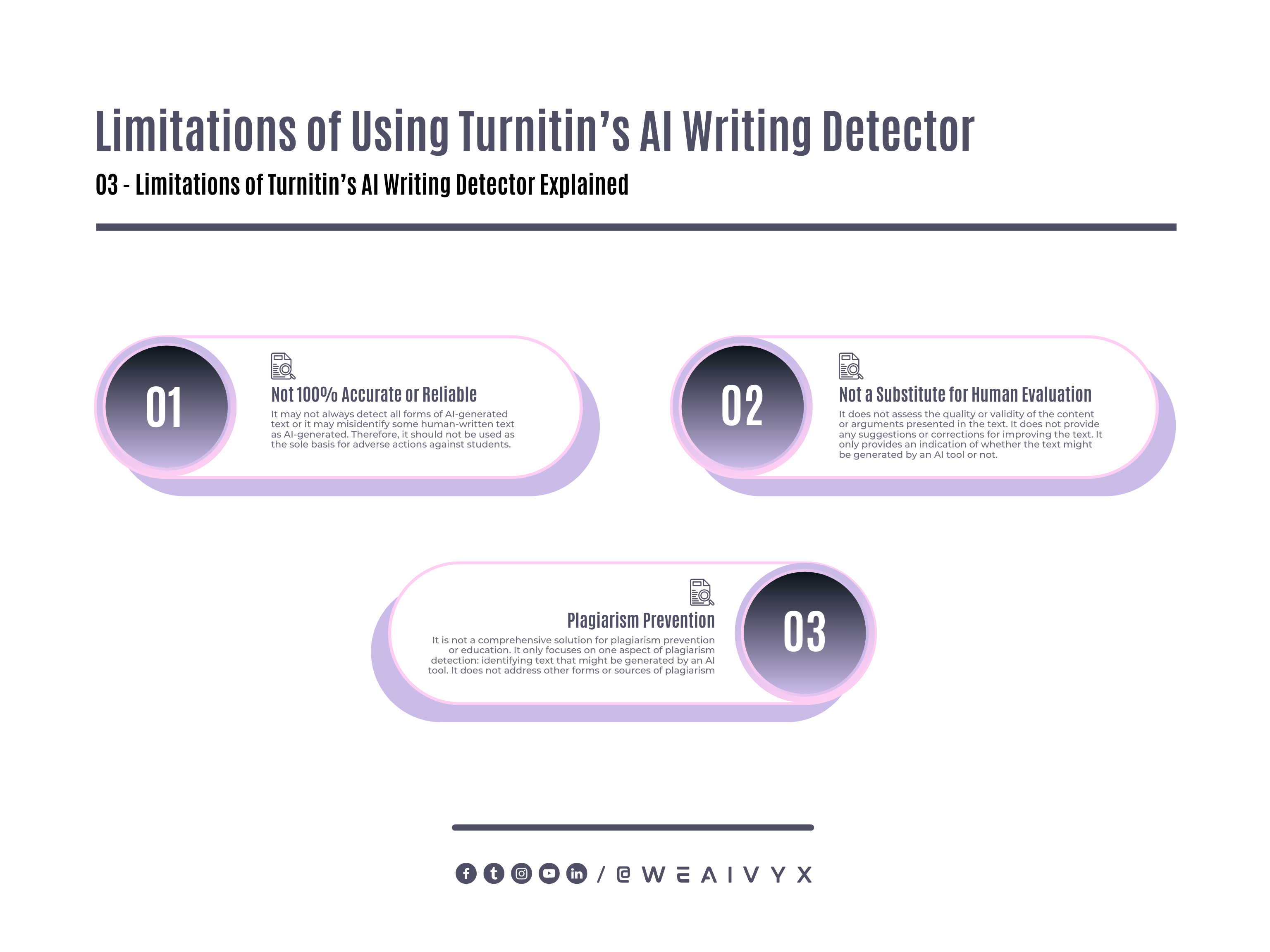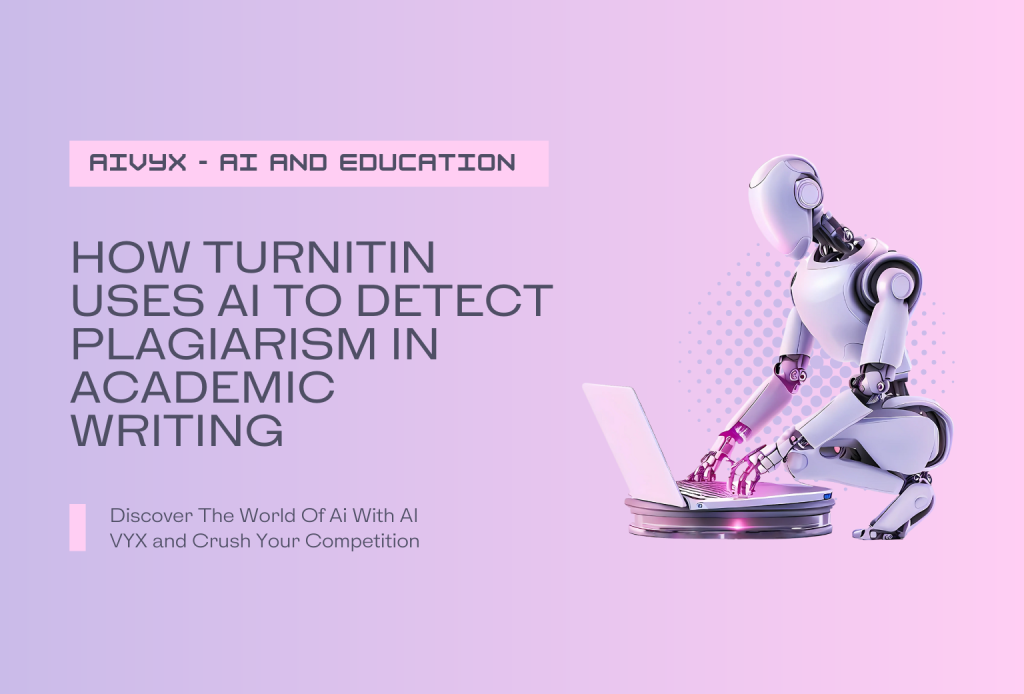Plagiarism is a serious issue in academic writing, as it can damage the reputation of students, researchers, and institutions.
Plagiarism can also undermine the quality and integrity of scientific knowledge and innovation.
But how can plagiarism be detected and prevented in the age of artificial intelligence (AI)?
AI writing tools, such as GPT-4, ChatGPT, and others, can generate realistic and coherent texts on any topic, making it easier for students and researchers to cheat or unintentionally plagiarize.
That’s why Turnitin, a leading provider of plagiarism detection software, has developed a new AI writing detector that can identify text that might be prepared by a generative AI tool.
In this blog post, we’ll explain how Turnitin’s AI writing detector works, what benefits it offers to educators and students, and what challenges and limitations it faces.
We’ll also share some best practices for avoiding plagiarism and using AI writing tools ethically and responsibly.
What is Turnitin’s AI Writing Detector?
Turnitin’s AI writing detector is a feature that is integrated into its core writing integrity products, such as Feedback Studio and Originality.
It is designed to help educators identify text that might be generated by an AI writing tool, such as GPT-4 or ChatGPT.
Turnitin’s AI writing detector uses a machine learning model that was trained on millions of texts from various sources, including human-written texts, AI-generated texts, and texts that were mixed or edited by humans or AI.
The model analyzes the text for various features, such as syntax, semantics, coherence, style, and tone, and assigns a percentage score that indicates the likelihood of the text being generated by AI.
The score ranges from 0 to 100%, with higher scores indicating a higher probability of AI-generated text.
The score is displayed in the side panel of the Similarity Report, along with an indicator that shows one of three possible states:
Blue: The submission has been processed successfully and contains some amount of qualifying text that was detected as AI-generated.
Gray: The submission could not be processed for AI writing detection due to various reasons, such as file size, word count, language, or file type.
Error: The submission failed to process due to technical issues.
To explore the results of the AI writing detection feature, educators can select the indicator to open the AI Writing Report.
The report shows the text segments that were detected as AI-generated, along with their scores and explanations.
The report also provides some tips and resources for educators to further investigate the source and quality of the text, as well as to engage in dialogue with students about academic integrity and the ethical use of AI writing tools.
What Are the Benefits of Turnitin’s AI Writing Detector?
Turnitin’s AI writing detector offers several benefits to educators and students who want to ensure the originality and quality of their academic writing.
Some of these benefits are:
It helps educators detect potential cases of plagiarism or academic misconduct that might otherwise go unnoticed by traditional plagiarism detection methods.
It helps educators provide feedback and guidance to students who might have used AI writing tools unintentionally or without proper citation and attribution.
It helps educators raise awareness and educate students about the ethical and responsible use of AI writing tools in academic writing.
It helps students avoid plagiarism and academic misconduct by discouraging them from using AI writing tools or encouraging them to use them properly and transparently.
It helps students improve their writing skills and critical thinking abilities by challenging them to produce original and high-quality texts that reflect their own voice and perspective.

What Are the Challenges and Limitations of Turnitin’s AI Writing Detector?
Turnitin’s AI writing detector is not a perfect solution for detecting plagiarism or academic misconduct in academic writing.
It has some challenges and limitations that educators and students should be aware of. Some of these are:
It Is Not 100% Accurate or Reliable
It may not always detect all forms of AI-generated text or it may misidentify some human-written text as AI-generated.
Therefore, it should not be used as the sole basis for adverse actions against students.
It requires further scrutiny and human judgment in conjunction with an organization’s specific academic policies to determine whether any academic misconduct has occurred.
Not a Substitute for Human Evaluation
It is not a substitute for human evaluation or feedback.
It does not assess the quality or validity of the content or arguments presented in the text.
It does not provide any suggestions or corrections for improving the text.
It only indicates whether the text might be generated by an AI tool or not.
Therefore, it should be used as a complementary tool to enhance human evaluation or feedback.
Not a Comprehensive Solution for Plagiarism
It is not a comprehensive solution for plagiarism prevention or education.
It only focuses on one aspect of plagiarism detection: identifying text that might be generated by an AI tool.
It does not address other forms or sources of plagiarism.

How to Avoid Plagiarism and Use AI Writing Tools Ethically and Responsibly?
Plagiarism is not only unethical but also illegal in some cases. It can have serious consequences for your academic and professional reputation, as well as legal ramifications.
Therefore, it is important to avoid plagiarism and use AI writing tools ethically and responsibly.
Here are some best practices for avoiding plagiarism and using AI writing tools in academic writing:
Understand the Types and Sources of Plagiarism
Plagiarism can take many forms, such as complete, direct, paraphrasing, self, patchwork, source-based, and accidental plagiarism.
Plagiarism can also come from various sources, such as books, journals, websites, blogs, social media, podcasts, videos, and AI writing tools.
You should be familiar with the different types and sources of plagiarism and how to recognize them.
Cite and Reference Your Sources Properly
Whenever you use someone else’s words, ideas, data, or images in your work, you should give credit to the source by using an appropriate citation style (such as MLA or APA) and providing a reference list at the end of your work.
You should also use quotation marks for direct quotes and paraphrase or summarize the source’s ideas in your own words.
You can use the free Scribbr Citation Generator to create correctly formatted citations in MLA or APA Style.
Use AI Writing Tools as a Starting Point or an Aid, Not as a Replacement for Your Work
AI writing tools can be useful for generating ideas, brainstorming, outlining, or drafting your work.
However, you should not rely on them to produce your final work or submit their output without reviewing and editing it.
You should always check the accuracy, quality, relevance, and originality of the text generated by AI writing tools and make sure it reflects your voice and perspective.
You should also cite and reference any AI writing tools you use in your work.
Be Transparent and Honest About Your Use of AI Writing Tools
If you use AI writing tools in your academic work, you should disclose this fact to your instructor or supervisor and explain how you used them and why.
You should also seek their permission and guidance before using any AI writing tools in your work.
You should not try to hide or deceive anyone about your use of AI writing tools or pretend that their output is your work.
Monitor the Performance and Impact of Your Work
After you submit or publish your work, you should monitor how it performs and impacts your audience. You should track metrics such as views, shares, comments, feedback, citations, etc.
You should also respond to any questions or suggestions from your audience and address any issues or concerns that may arise from your use of AI writing tools.
By following these best practices, you can avoid plagiarism and use AI writing tools ethically and responsibly in academic writing.
You can also improve your writing skills and critical thinking abilities and produce original and high-quality work that showcases your own voice and perspective.

Conclusion
Turnitin’s AI writing detector is a feature that helps educators identify text that might be generated by an AI writing tool.
It uses a machine learning model that analyzes the text for various features and assigns a score that indicates the likelihood of the text being generated by AI.
Turnitin’s AI writing detector offers several benefits to educators and students who want to ensure the originality and quality of their academic writing.
However, it also has some challenges and limitations that require further scrutiny and human judgment.
To avoid plagiarism and use AI writing tools ethically and responsibly in academic writing, you should understand the types and sources of plagiarism, and cite and reference your sources properly.
Use AI writing tools as a starting point or an aid, be transparent and honest about your use of AI writing tools, and monitor the performance and impact of your work.
We hope this blog post has given you some useful information about Turnitin’s AI writing detector and how to use it effectively in academic writing.
If you have any questions or comments about this topic, please feel free to share them below. We’d love to hear from you!
